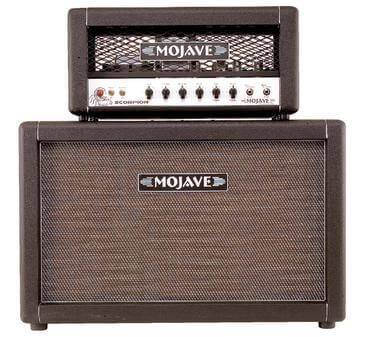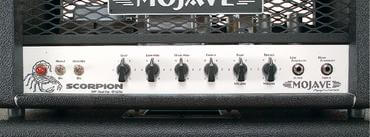
Anyone familiar with Mojave Ampworks founder Victor Mason’s other venture — a California dealership of vintage British amplifiers known as the Plexi Palace — will be aware of this amp maker’s fanaticism for classic Marshall-style tones. The Scorpion outwardly appears to take a serious stab at satiating that craving in a modern package, but don’t be too quick to label this 50-watter as simply a Marshall plexi update. While the Scorpion certainly aims squarely at the big Brit-rock tones of the late 1960s and early ’70s, it’s nowhere near to being a clone, and the design has enough clever twists to make it an entirely original creation. Although nominally a 50-watter, the Scorpion aims to provide big-box 100-watt sound and feel in a small package.
 The core of the Scorpion’s sonic DNA revolves around that big, crunchy, dynamic EL34 sound with the characteristically thumping lows and singing highs. But this model redraws the roadmap that takes you there, and adds plenty of new ingredients in the name of versatility. Mojave keeps the adjustable fixed-bias output stage with a dash of negative feedback, cathode-follower tone stack, and solid-state rectification that partly define the post-1967 Marshall 50-watters, but re-labels the tone stack as Bass, Low Mid, High Mid, and Treble, with High Mid taking the job of a Presence control. It also employs a nifty trick in the preamp stage that has become something of a Mojave standard: internally ganging together two different first gain stages comprised of an independent, parallel-wired twin-triode 12AX7 for each—one voiced to emphasize bass, the other to emphasize treble—and providing a Volume control for each so you can blend them together. This is not a master volume amp, but it carries a Power Dampening control on the back panel that governs a unique proprietary circuit that reins in volume levels at the output stage, allowing you to take the Scorpion from 50 watts down to 3 watts, and anywhere in between. Other features include High and Low Sensitivity inputs, and a back panel 1/4″ Line Out jack with a Level control and ground lift alongside dual 8- and single 16-ž outputs.
The core of the Scorpion’s sonic DNA revolves around that big, crunchy, dynamic EL34 sound with the characteristically thumping lows and singing highs. But this model redraws the roadmap that takes you there, and adds plenty of new ingredients in the name of versatility. Mojave keeps the adjustable fixed-bias output stage with a dash of negative feedback, cathode-follower tone stack, and solid-state rectification that partly define the post-1967 Marshall 50-watters, but re-labels the tone stack as Bass, Low Mid, High Mid, and Treble, with High Mid taking the job of a Presence control. It also employs a nifty trick in the preamp stage that has become something of a Mojave standard: internally ganging together two different first gain stages comprised of an independent, parallel-wired twin-triode 12AX7 for each—one voiced to emphasize bass, the other to emphasize treble—and providing a Volume control for each so you can blend them together. This is not a master volume amp, but it carries a Power Dampening control on the back panel that governs a unique proprietary circuit that reins in volume levels at the output stage, allowing you to take the Scorpion from 50 watts down to 3 watts, and anywhere in between. Other features include High and Low Sensitivity inputs, and a back panel 1/4″ Line Out jack with a Level control and ground lift alongside dual 8- and single 16-ž outputs.
 As alluring as it might be from the outside, much of the Scorpion’s appeal reveals itself when you pull the chassis from the cab. This amp is hand built to some of the most exacting standards found in the market today.
As alluring as it might be from the outside, much of the Scorpion’s appeal reveals itself when you pull the chassis from the cab. This amp is hand built to some of the most exacting standards found in the market today.
Powder-coated black metal grilles protect components front and back, and the brand is boldly represented by an acid-etched aluminum nameplate. The rugged turret board follows a linear layout from input to output stage, and the flying-lead connections to transformers, potentiometers, switches, and tube sockets (all chassis mounted) are made with Teflon-insulated, silver-plated copper wire. While many amp makers swear by old-style carbon comp resistors for “warmth” and “vintage authenticity,” Mojave uses high-grade metal film resistors because they can be obtained in more precise values, and generally result in a lower noise floor. These share the board with Sprague filter capacitors and custom-made, one-percent tolerance film and foil polypropylene signal capacitors. Transformers are all custom made for Mojave by the highly regarded Mercury Magnetics company, and the whole shebang is bolted together in a reinforced aluminum chassis. Finally, the output transformer presents a novel twist on the classic 50-watter formula, as Mojave has spec’d it for “triple-capacity,” which can handle as much as three times the Scorpion’s 50-watt output. This approach can achieve the response of a 100-watt stack in a smaller amp, resulting in firmer lows and remarkable headroom.
Our review sample came with the 2×12 semi-open-back cab loaded with Celestion G12H-30s, but a closed-back 4×12 is also available for $985 retail. The cabinet is a robust, yet portable unit with a single, recessed handle positioned top center.
I tested the Scorpion with a range of guitars, including a Fender Stratocaster and a Telecaster, a Gibson SG Special, and a PRS Singlecut Trem. The overriding impression this amp left with me was one of power, body, and massive volume — even with single-coil pickups. This is one massive sounding amplifier, and Mojave has certainly achieved the goal of attaining 100-watt-style performance in a 50-watt package. It delivers a wide, blooming soundstage with tight, but not overly booming lows, a thumping midrange, and glittery, yet nicely recessed highs. In short, you get broad, punchy, in-your-face dynamics across a frequency spectrum that’s very flattering to rock guitar.
With the Strat and Tele, the Scorpion exhibited stunning clarity and superior headroom up to about a ten o’clock position of the Volume controls, at which point it was already too loud for home studios, basement rehearsals, and many club gigs. Humbuckers and P90s brought out the raunch a little sooner. Roll it up from there, and you segue through toothsome crunch to absolutely screaming lead tones — both of which are easily cleaned up at the guitar’s Volume control. This is the fat, tactile, airy, classic sound that arena-rock dreams are made of, and when you get the volume up anywhere from one to five o’clock, it’s a rare and spine-chilling experience to just stand in front of this rig and wail. Tweak the EQ to taste, put a booster or distortion pedal in front of it as desired (all of which this amp handles very well), and there’s very little in the broad fields of rock, blues-rock and metal that it can’t do.
That said, the trend these days is toward downsizing, and plenty of players are looking for amps that sound like cranked 50-watters in 15-watt packages, not 50-watters that sound like a 100-watters. The Scorpion’s Power Dampening control is a cool feature that brings levels down as much as you’d like, but it does color the tone a little bit, and you also need to dial down the Volume controls to retain similar headroom at lower volumes. In short, this powerful monster is most cut out for serious rockers who expect to put in most of their playing hours on large stages.
The Scorpion also sounded fantastic through the 2×12 cabinet, which seemed to take everything I could throw at it without breaking a sweat. But if you plan to play this amp toward max in big venues, you might consider pairing it with Mojave’s 4×12 cab. I ran the Scorpion through a custom 4×12 with G12H-30s in my rehearsal space, and it proved an equally thrilling endeavor, with that huge kick in the gut that lets you know you’re pushing a lot of air. However, it wasn’t demonstrably louder than Mojave‘s very efficient, compact open-back 2×12, so the choice is yours. But whatever you blast it through, this is an extremely accomplished-sounding, as well as a stunning piece of craftsmanship.


Source: https://mercurymagnetics.com/pages/news/GuitarPlayer/GPAug07.htm